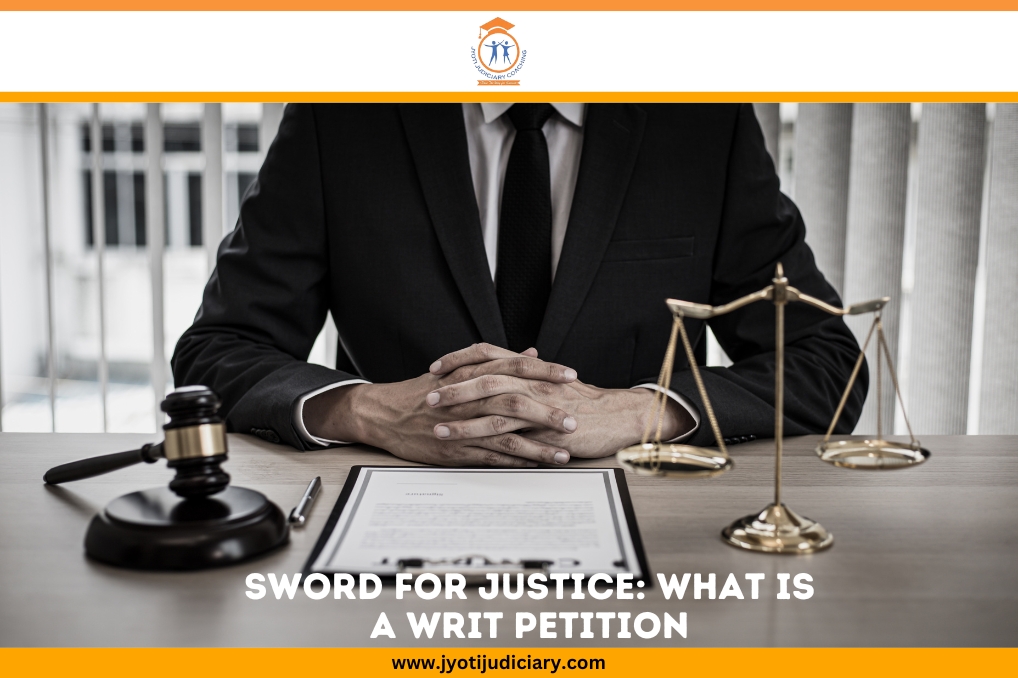
The writ petition is an effective instrument in the realm of law, frequently used by people seeking redress against injustice or excessive authority by the government. Writs, that have their roots in the English system of law, serve as vital for ensuring the upholding of basic rights and freedoms. Understanding the importance, and function of writ petitions for upholding the supremacy of law is required for understanding their fundamentals.
What is a Writ Petition?
- A writ is a type of legal document that resembles a written injunction that a higher court issues.
- When an Indian citizen’s fundamental rights are violated, these writs under the Indian constitution are granted to subordinate courts or to specific individuals.
- The Supreme Court writ petition is mentioned under Article 32 of the Indian Constitution which grants the Supreme Court the ability to issue writs to authorities or entities. This implies that they are able to use this constitutional clause to issue an order to the Supreme Court of India. This provides the authority with a way to file a complaint or seek legal recourse for its complaints or grievances against the government or any other individual or organization.
- a high court writ petition is mentioned under Article 226 of the Indian Constitution. These writs contest decisions made by subordinate courts, persons, or their separate authorities.
Meaning of Writ Petition
Before Indian law, a Writ Petition is a formal written request or application that is made before a higher court, usually, the Supreme Court or the High Court, requesting judicial justice and intervention for cases involving infringement of basic rights or cases that need immediate attention.
What is a Writ Application: Eligibility
- It is often acceptable to submit a writ application on behalf of someone who is purportedly being detained illegally.
- When someone is being held in custody, their friend or family may submit a Habeas Corpus application on their behalf.
- With this application, you are asking the court to consider the circumstances surrounding the arrest and decide whether or not the person’s detention was lawful.
- This application’s main goal is to place the applicant under custody so that the court can conduct a fair review.
- Another reason a third party might file a habeas corpus petition is if there’s a chance the detainee would be detained incommunicado. It is crucial to realize that habeas corpus has certain restrictions.
- It is crucial to realize that habeas corpus has certain restrictions. Its main function is to protect against wrongful detention; other rights, such as the right to a fair trial, are only infrequently addressed.
How to File a Writ Petition?
In order to submit a writ petition in either of the courts, the following steps must be taken:
- Initially, the person who feels wronged must go to a certain organization with the required paperwork, including proof of identity, proof of residence, and photos, among other things.
- The petition must then be drafted with legal assistance. The document contains the name, address, and circumstances that led to the infringement of the offended party’s fundamental rights.
- The petition’s draft is then sent to the court following this procedure.
- Ultimately, upon hearing from all sides, the court renders a decision and provides the appropriate remedies.
Petition of Writ: Types
There are various writs, and each has a distinct function. The most typical kinds consist of:
- Habeas Corpus: This writ protects a person’s right to privacy and personal freedom. It is used to contest wrongful imprisonment or detention.
- Mandamus: A mandate is a legal document that is used to force a government agency or public official to carry out an action that is required of them by law.
- Prohibition: This writ is issued by a higher court to stop a lower court or tribunal from acting illegally or beyond its authority.
- Certiorari: When an inferior court, tribunal, or quasi-judicial body acts outside of its power, it can use certiorari to overturn the decision.
- Quo Warranto: This legal strategy is used to contest the legitimacy of an individual occupying a public office and to look into the credentials that allow that individual to hold that position.
Numerous rights are granted to us by our constitution. Fundamental rights are among the most significant rights guaranteed by our constitution. These rights are crucial for personal growth, as their name implies. Since rights exist, they can be violated. Thus, under Articles 226 and 32, respectively, a person may file five different forms of writs before a High Court or the Supreme Court to defend these rights.
Writ Petition FAQs
1. Who can file a writ petition?
When the State violates someone’s fundamental rights, they can file a writ petition in the Supreme Court, but when the State violates someone else’s rights, they can file a writ petition in the High Court.
2. What is a petition under Article 32?
A writ petition may be submitted to the Supreme Court by Article 32. Only in the event that the petitioner can demonstrate that his fundamental rights have been violated would the Supreme Court grant a writ.
3. When a writ petition is filed?
Writ petitions are usually filed in cases where someone’s fundamental rights have been violated or when they have been the victim of injustice. Writs, which are positioned by the constitution as a remedial mechanism, are essential for holding the country’s law enforcement agencies responsible.
4. Who can issue writs?
Writs are granted in India by the High Court pursuant to Article 226 of the Indian Constitution and by the Supreme Court pursuant to Article 32 of the Indian Constitution.
5. Why do we file writ petitions?
Defending people against unjust judicial orders, writ petitions shield people against unfair rulings made by the courts.
6. What do you mean by mandamus?
In literal terms, mandamus means “we command.” It is an order from the court for a public official to carry out official obligations that they have neglected or declined to carry out.
7. How many writ petitions are there?
There are five different kinds of writs: Habeas Corpus, Mandamus, Certiorari, Quo Warranto, and Prohibition. These writs are all useful tools for upholding citizens’ rights and requiring the government to carry out their legal obligations.
8. What are the grounds for a writ petition?
A lower court or tribunal receives this writ from a higher authority court, directing them to either transfer a case that is pending with them to themselves or revoke an order they have made in a case. It is issued due to an overabundance of authority, a deficiency in jurisdiction, or a legal error.
9. Is a writ petition civil or criminal?
Article 226 and Article 32 of the Indian Constitution provide for the filing of writ petitions for both civil and criminal cases in the High Court and the Supreme Court, respectively.
10. What happens if a writ petition is dismissed?
The petition’s legal arguments were rejected on their grounds. Because of this, it is evident that the writ petition was denied on its own merits, and as a result, the denial of the writ petition establishes a barrier to the current petition’s eligibility under Article 32.
11. What is the limitation period for writ?
Nevertheless, there is no deadline for submitting a writ petition.
12. Do writs expire?
A writ of execution has an expiration date. State regulations determine the duration, which could be five years or more. The judgment creditor may take action to carry out the writ during this period. For instance, the debtor might not have any assets at the moment, but they might in the future.
With the goal of giving students the best coaching available for law entrance exams including the CLAT, AILET, and various other numerous state judiciary exams, Jyoti Judiciary Coaching, India’s Finest educational Platform, was established. Come enroll now with Jyoti Judiciary!
For any latest news, legal topics, judiciary exams notifications, patterns, etc watch Jyoti Judiciary’s YouTube channel for legal videos for any updates at https://youtube.com/@jyotijudiciarycoaching4852?si=2cwubh9d2A9urwJf









